Pallet Informational Guide
What are pallets and how are they used in the
garment industry?
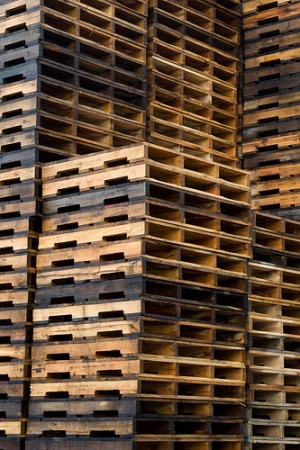 Pallets are platforms or stands
that are used for transportation and storage of goods. They are used
particularly in industrial applications like export of clothes, shoes, or
fashion accessories. There are different kinds of pallets used for different
applications: rackable pallets that are suitable for multi-rack storage systems
and non-rackable pallets that are suitable for heavy weight storage applications
at floor level. Pallets are also categorized as static/ dynamic and light
/medium /heavy /extra-heavy. Printers pallets, double-sided pallets, four-sided
pallets, shuttle pallets, newspaper pallets, roll cradle pallets and reinforced
pallets are the other kinds of pallets available.
Pallets are platforms or stands
that are used for transportation and storage of goods. They are used
particularly in industrial applications like export of clothes, shoes, or
fashion accessories. There are different kinds of pallets used for different
applications: rackable pallets that are suitable for multi-rack storage systems
and non-rackable pallets that are suitable for heavy weight storage applications
at floor level. Pallets are also categorized as static/ dynamic and light
/medium /heavy /extra-heavy. Printers pallets, double-sided pallets, four-sided
pallets, shuttle pallets, newspaper pallets, roll cradle pallets and reinforced
pallets are the other kinds of pallets available.
Pallets can be made of either plastic, cardboard, or
wood. Wood pallets are very cost- effective but have problems like fungus, nails
and splinters, pests and insects. They are also difficult to dispose of, and
hence, they are being increasingly replaced with plastic pallets. Light-weight
thermoplastic pallets are gaining popularity because they are recyclable,
insulating, light weight and environment friendly. Besides, they do not have the
problem of being infested with insects. Cardboard pallets, on the other hand,
are fragile and are thus not suitable for all kinds of applications.
Pallets are used for storing goods at one place and
also for taking goods from one place to another, like factory to warehouse or
warehouse to stores. These days, pallets are being manufactured using very
advanced technologies to make them stronger and more durable. Some pallets are
also insulated, which makes them ideal for storing perishables. Pallets should
be ideally FDA/uDSA compliant, UL fire rated, hygienic, and easy to clean.
Pallets come in
different sizes, most
commonly 800mm x 1200mm and 1000mm x 1200mm. There are also many different
designs that can be customized as per user requirements. Wooden pallets are
priced at $8 to $10 if new and around $4-$6 if used. Old wooden pallets are
either refurbished or made into wooden chips, compost, animal bedding, or
landscape mulch. There are many companies that sell refurbished pallets. They
also undertake repair and maintenance of the pallets. These days, pallets are
also being attached with radio frequency identification technology to make
tracking easier.
What can be done to keep dust off pallets?
Pallet covers not only protect the
pallets from dust but also provide insulation against excessive humidity, thus
lowering the chance of rusting, scratches, and corrosion. They also protect
wooden pallets from insects and keep the contents of the pallets safe. They also
keep the pallets separated from one another. Pallet covers are a very
cost-effective alternative to cardboard boxes.
There are different kinds of pallet covers: clear,
flat polyethylene, heavy duty/light duty, waterproof, disposable/reusable, etc.
Pallet covers are also available in various sizes. They can also be ordered as
per requirements. Pallet covers are generally ordered in bulk. Sizes range from
72 to 102 in length for short as well as tall pallets. There are also perforated
covers available in the form of a roll. Some covers have pleated sides for
flexibility in expansion. Some suppliers provide reusable pallet covers that are
made of durable canvas, suitable for all weather conditions. These covers are
also resistant to mildew and mold. Other attractions include Velcro openings for
easy accessibility, draw cords at the bottom for insulation, double-thick canvas
surface, etc. Pallet covers are also custom designed to suit individual
requirements. They are available in different colors, as well as with
personalized logos or markings on the cover for a customized look.
How do we move heavy pallets?
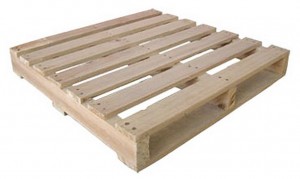 Pallet trucks are for moving pallets from one place
to another. Pallet trucks make transportation of pallets easier and ease loading
and unloading while ensuring safety. They can also minimize time of transport
considerably. Since the pallets can be rather heavy, pallet trucks need to be
very strong. Pallet trucks are generally used in chemical and pharmaceutical
factories, warehouses, food storage facilities, and retail stores. Most pallet
trucks can move loads of around 4000 lbs.
Pallet trucks are for moving pallets from one place
to another. Pallet trucks make transportation of pallets easier and ease loading
and unloading while ensuring safety. They can also minimize time of transport
considerably. Since the pallets can be rather heavy, pallet trucks need to be
very strong. Pallet trucks are generally used in chemical and pharmaceutical
factories, warehouses, food storage facilities, and retail stores. Most pallet
trucks can move loads of around 4000 lbs.
Pallet trucks are designed to suit all kinds of
environments and terrains, including highly corrosive and unsanitary conditions.
Some pallet trucks are made from zinc and stainless steel; they are chrome
coated and galvanized to resist even the highly moist atmospheres of
pharmaceutical and chemical factories. There are pallet trucks suitable for
clean room, laboratory, wash down, and corrosive material handling applications.
There are different types of pallet trucks: low
profile pallet trucks, pallet trucks with scales (for weighing loads),
big-wheeler pallet trucks (for uneven floors and heavy loads), specialty pallet
trucks (made of zinc or stainless steel for unsanitary environments), wheel-nose
pallet trucks (for placing pallets closely in a row), ergonomic pallet trucks
(for ease of operation), economic pallet trucks, "Freight-Saver" pallet trucks,
all-terrain pallet trucks, foldable pallet trucks (light-duty trucks for going
down narrow aisles, through doorways, and around tight corners), and electric
pallet trucks (with AC drive motors, battery packs and regenerative braking
systems).
Some pallet trucks also have adjustable push rods, a
wide turning radius, a skin adaptor, and an integral scale. There are some
highly advanced pallet trucks that contain a printer, an LCD display, and a
keypad with auto-tare functions that work on rechargeable batteries.
You may also want to learn
about forklifts.
How do we store numerous cartons of clothing?
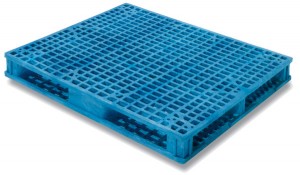 Since cartons of clothing can be crushed if pilled
too high, product cannot be piled directly upon each other to an extreme.
Pallets are preferred; the pallets can be stored upon each other, thus
minimizing space considerably. Pallet storage, is often
done under controlled temperature and humidity. The conditions will depend
on the warehouse or other storage facility that you select. Pallets can
also be loaded or unloaded using special lifts and trucks, thus minimizing
damage to the goods. It is possibly better to use battery-powered pallet
movers, as fumes from gasoline can affect the goods.
Since cartons of clothing can be crushed if pilled
too high, product cannot be piled directly upon each other to an extreme.
Pallets are preferred; the pallets can be stored upon each other, thus
minimizing space considerably. Pallet storage, is often
done under controlled temperature and humidity. The conditions will depend
on the warehouse or other storage facility that you select. Pallets can
also be loaded or unloaded using special lifts and trucks, thus minimizing
damage to the goods. It is possibly better to use battery-powered pallet
movers, as fumes from gasoline can affect the goods.
Some things to be considered for pallet storage are
the size of the storage, the structural design, the environmental control
mechanism, the management of the pallets, and so on. Storage sizes vary greatly
according to the kind of product. Smaller bins are preferred for perishable
goods since the turnover is faster. While considering the structural design, pay
attention to the strength of the floor and walls and the forces on the roof
system from wall pressure. The pallets and the pallet racks should be moisture
resistant and well insulated. Sanitization should be easier.
Where do we keep the full pallets?
Pallet racks are the stands where
pallets can be stored. Each rack can effectively hold hundreds of pallets,
depending on the size. Pallet racks are excellent for managing space within a
warehouse or a store.
There are different kinds of pallet racks: pushback
pallet racks, selective pallet racks, pallet flow racks, reel racks, double-deep
selective, carpet racks, seismic racks, bolt connection racks, boat racks, empty
pallet storage racks, mezzanine racks, custom/combination racks, die storage
racks, structural racks, drive-in pallet racks, and drive-through pallet racks.
Every industrial application or area has different
pallet rack needs. Hence, these can be custom designed as per user
specifications. Pallet racks can be designed using CAD system design. Some of
the things useful for designing a pallet rack system are a study of the user
requirements, the floor plan, and the kind of pallets that need to be
accommodated. The main steps in designing a pallet rack are to determine the
length and depth of the pallet; determine the load depth, load width, and load
height of the largest load; determine the front-to-back depth of the uprights as
well as the beam width; check the beam and frame capacities and the beam spacing
between the beams as well as from the floor to the first beam. Other things to
be considered while buying a pallet rack are the frame depth, frame height, beam
length, anchoring, back-to-back clearance, etc. The different accessories
available along with a pallet rack are wire rack decking, post cushion guards,
post protectors, row spacers, front-to-back supports, steel guard rails and
others.
Can we buy used pallet racks?
Used pallet racks are also available from most
suppliers. They can be found in all shapes, sizes, models, colors, and
configurations. These racks are obtained from warehouses, are refurbished and
repaired according to quality specifications, and are then resold.
There are several advantages to buying a used pallet
rack as opposed to buying a new one: the low cost, the tax advantages of buying
used equipment, and lowered interstate freight costs. The main aspects to be
considered while buying a used pallet rack are the age of the rack, the
condition of the rack, whether or not it has been inspected, whether or not the
supplier will give a guarantee in writing, the integrity of the dealer, the
available repair records and the type of environment in which the rack was
previously used.
Make sure that the rack is in good condition; get it
checked by a specialist if possible. Find out if the price is worth the
equipment because price of used equipment is generally negotiable. Check for
several models and styles before deciding on a particular one. Be aware of your
needs and requirements.
Newspaper classifieds, dealer's advertisements, and
internet websites are generally not good sources for buying used pallet racks.
It is better to visit a dealer and examine the equipment personally.
Learn about Pallet Rack Systems:
Pallet rack systems can be designed as per user
requirements. Customers need to take strength, safety, and value into concern.
These days, pallet racks are being subjected to strict quality norms. Hence,
they have to be reliable even under extreme conditions.
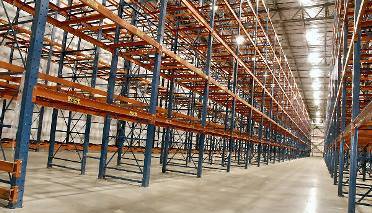 Designing of pallet rack systems is very complex. With
advanced handling equipment, like very narrow aisle turret truck and high bay
elevations, rack systems have very stringent tolerances. Additionally, the kinds
of racks have also increased: pushback pallet racks, selective pallet racks,
pallet flow rack, reel rack, double-deep selective, carpet rack, seismic rack,
bolt connection rack, boat rack, empty pallet storage racks, mezzanine rack,
custom/combination rack, die storage rack, structural rack, drive-in pallet
racks, and drive-through pallet racks. This has made designing pallet racks all
the more difficult. Another aspect is that these days it is mandatory for the
systems to be resistant to seismic activity. However, not all pallet rack
systems need to comply with this requirement.
Designing of pallet rack systems is very complex. With
advanced handling equipment, like very narrow aisle turret truck and high bay
elevations, rack systems have very stringent tolerances. Additionally, the kinds
of racks have also increased: pushback pallet racks, selective pallet racks,
pallet flow rack, reel rack, double-deep selective, carpet rack, seismic rack,
bolt connection rack, boat rack, empty pallet storage racks, mezzanine rack,
custom/combination rack, die storage rack, structural rack, drive-in pallet
racks, and drive-through pallet racks. This has made designing pallet racks all
the more difficult. Another aspect is that these days it is mandatory for the
systems to be resistant to seismic activity. However, not all pallet rack
systems need to comply with this requirement.
The main aspects to consider while designing pallet
rack systems are the operational requirements like storage density, ease of
operation while accessing the pallets, retrieval requirements, and so on. The
kind of construction is also important. Choice can be made between hot-rolled
structural steel and cold-roll formed kinds. The hot-rolled structural steel
kind of systems is more robust and resistant to damage from lift truck impact,
but it is also more expensive.
Most rack failures are attributed to overloading, lift
truck damages, or badly engineered systems. It is very important that the load
should not cause too much deflection of the beam. There are many other
technologies that can be adopted for greater safety from the pallet rack systems
like fire baffles or in-rack fire suppression. Manufacturers would be able to
determine the exact kind of pallet rack systems needed by analyzing the
requirements.
What about returnable plastic packaging to help
the environment?
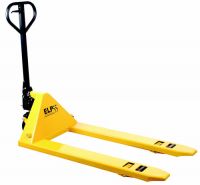 Heavy gauge thermoforming is as much a staple to
the returnable plastic packaging industry as Chevy is to General Motors. It's
always been there, not known for its cutting edge design but more because it is
solid, durable, and dependable. Thermoforming plastic trays and pallets can also
be misunderstood. It remains one of the longest lasting and reasonably priced
returnable packaging products available yet customers are reluctant to try it.
Why?
Heavy gauge thermoforming is as much a staple to
the returnable plastic packaging industry as Chevy is to General Motors. It's
always been there, not known for its cutting edge design but more because it is
solid, durable, and dependable. Thermoforming plastic trays and pallets can also
be misunderstood. It remains one of the longest lasting and reasonably priced
returnable packaging products available yet customers are reluctant to try it.
Why?
Research has shown that many people assume plastic
trays and pallets made via heavy gauge thermoforming have the same high priced
tooling as injection molding. Further, many folks are convinced the tooling
takes just as long to produce. This is not true. Returnable plastic trays and
pallets come with a moderate tooling charge (usually less than $7500) and can be
made in 4 weeks or less, depending on the design.
Here are 10 tips regarding thermoformed plastic trays
and pallets your salesman would rather you not know about:
1. Provide the actual product you need packaged to
your supplier. This allows the supplier to see, touch, and feel the product and
design the plastic tray or plastic pallet accordingly. you'll get a better
initial design and a firmer price quote.
2. Assess if your actual product can be stacked upon
and support weight. If this is possible, your returnable plastic trays will not
need to be as deep which means a smaller plastic tray and a lower price per
tray.
3. Design returnable plastic trays and plastic
pallets that are stackable and nestable. This means that the plastic trays and
plastic pallets can stack when fully loaded and nest inside each other when
empty. Nested thermoformed plastic trays and plastic pallets take up less space
and save on both storage and freight costs.
4. Consider having the thermoformed plastic trays
marked with a stripe at least 1 inch wide and running either the entire length
or width in a different color than the plastic trays. These stripes help your
operators know when the plastic trays are loaded or empty, saving in labor costs
and storage efficiency
5. Ask for concept sketches with overall dimensions
of your plastic trays or plastic pallets before proceeding with a production
order. This helps everyone remain clear on how the plastic trays or plastic
pallets need to look and function.
6. Make a production tool for your thermoformed
plastic trays instead of a wood prototype tool if possible. Prototype tooling is
very rough and takes about 2 weeks to make. Production tooling can be modified
and adjusted, within reason. This speeds up the overall design and production
schedule and saves on the additional cost of a prototype tool which is worthless
after it is used once
7. Evaluate different thicknesses of plastic once
your production tooling is done. If a thermoformed plastic tray or plastic
pallet could be made using thinner material this will save money. It is also
possible a thicker material will perform better after thermoforming. You can see
the difference and make an educated decision before running a large quantity.
8. Mark your thermoformed plastic trays or plastic
pallets with an identification stamp or insert plate that has your company name,
address, and any other important information such as Property of XYZ
Corporation. This will help assure that the plastic trays or plastic pallets are
returned to the correct address when empty.
9. Ask your supplier if they will purchase your
thermoformed plastic trays or plastic pallets for recycling if and when they
become obsolete. The price paid will be a scrap value but it is better than
nothing.
10. Consider purchasing 10-25 extra plastic trays or
pallets with your initial order for emergencies. Most companies misplace plastic
trays and pallets and it is much more cost effective to run them in a larger
quantity than having to pay for a special run later on.
Thermoformed Plastic Trays and Pallets Conclusion
If shipping parts to a dedicated customer or
destination on a regular basis, consider thermoformed plastic trays and pallets
as a packaging solution. While they aren't indestructible, they can handle
normal abuse and easily pay for themselves within 1 to 1 years. As always, rely
on your packaging professional for guidance and direction.
Learn about the following:
Shrink Wrap & Strap
Pallets
Floor Load
verse Palletize
Apparel Search
Add Your Company
Contact
Us About Us
Advertise
News Letter
Legal
Help
Copyright © 1999-2023 Apparel Search Company. All Rights Reserved.
 Pallets are platforms or stands
that are used for transportation and storage of goods. They are used
particularly in industrial applications like export of clothes, shoes, or
fashion accessories. There are different kinds of pallets used for different
applications: rackable pallets that are suitable for multi-rack storage systems
and non-rackable pallets that are suitable for heavy weight storage applications
at floor level. Pallets are also categorized as static/ dynamic and light
/medium /heavy /extra-heavy. Printers pallets, double-sided pallets, four-sided
pallets, shuttle pallets, newspaper pallets, roll cradle pallets and reinforced
pallets are the other kinds of pallets available.
Pallets are platforms or stands
that are used for transportation and storage of goods. They are used
particularly in industrial applications like export of clothes, shoes, or
fashion accessories. There are different kinds of pallets used for different
applications: rackable pallets that are suitable for multi-rack storage systems
and non-rackable pallets that are suitable for heavy weight storage applications
at floor level. Pallets are also categorized as static/ dynamic and light
/medium /heavy /extra-heavy. Printers pallets, double-sided pallets, four-sided
pallets, shuttle pallets, newspaper pallets, roll cradle pallets and reinforced
pallets are the other kinds of pallets available. Pallet trucks are for moving pallets from one place
to another. Pallet trucks make transportation of pallets easier and ease loading
and unloading while ensuring safety. They can also minimize time of transport
considerably. Since the pallets can be rather heavy, pallet trucks need to be
very strong. Pallet trucks are generally used in chemical and pharmaceutical
factories, warehouses, food storage facilities, and retail stores. Most pallet
trucks can move loads of around 4000 lbs.
Pallet trucks are for moving pallets from one place
to another. Pallet trucks make transportation of pallets easier and ease loading
and unloading while ensuring safety. They can also minimize time of transport
considerably. Since the pallets can be rather heavy, pallet trucks need to be
very strong. Pallet trucks are generally used in chemical and pharmaceutical
factories, warehouses, food storage facilities, and retail stores. Most pallet
trucks can move loads of around 4000 lbs. Since cartons of clothing can be crushed if pilled
too high, product cannot be piled directly upon each other to an extreme.
Pallets are preferred; the pallets can be stored upon each other, thus
minimizing space considerably. Pallet storage, is often
done under controlled temperature and humidity. The conditions will depend
on the warehouse or other storage facility that you select. Pallets can
also be loaded or unloaded using special lifts and trucks, thus minimizing
damage to the goods. It is possibly better to use battery-powered pallet
movers, as fumes from gasoline can affect the goods.
Since cartons of clothing can be crushed if pilled
too high, product cannot be piled directly upon each other to an extreme.
Pallets are preferred; the pallets can be stored upon each other, thus
minimizing space considerably. Pallet storage, is often
done under controlled temperature and humidity. The conditions will depend
on the warehouse or other storage facility that you select. Pallets can
also be loaded or unloaded using special lifts and trucks, thus minimizing
damage to the goods. It is possibly better to use battery-powered pallet
movers, as fumes from gasoline can affect the goods. Designing of pallet rack systems is very complex. With
advanced handling equipment, like very narrow aisle turret truck and high bay
elevations, rack systems have very stringent tolerances. Additionally, the kinds
of racks have also increased: pushback pallet racks, selective pallet racks,
pallet flow rack, reel rack, double-deep selective, carpet rack, seismic rack,
bolt connection rack, boat rack, empty pallet storage racks, mezzanine rack,
custom/combination rack, die storage rack, structural rack, drive-in pallet
racks, and drive-through pallet racks. This has made designing pallet racks all
the more difficult. Another aspect is that these days it is mandatory for the
systems to be resistant to seismic activity. However, not all pallet rack
systems need to comply with this requirement.
Designing of pallet rack systems is very complex. With
advanced handling equipment, like very narrow aisle turret truck and high bay
elevations, rack systems have very stringent tolerances. Additionally, the kinds
of racks have also increased: pushback pallet racks, selective pallet racks,
pallet flow rack, reel rack, double-deep selective, carpet rack, seismic rack,
bolt connection rack, boat rack, empty pallet storage racks, mezzanine rack,
custom/combination rack, die storage rack, structural rack, drive-in pallet
racks, and drive-through pallet racks. This has made designing pallet racks all
the more difficult. Another aspect is that these days it is mandatory for the
systems to be resistant to seismic activity. However, not all pallet rack
systems need to comply with this requirement. Heavy gauge thermoforming is as much a staple to
the returnable plastic packaging industry as Chevy is to General Motors. It's
always been there, not known for its cutting edge design but more because it is
solid, durable, and dependable. Thermoforming plastic trays and pallets can also
be misunderstood. It remains one of the longest lasting and reasonably priced
returnable packaging products available yet customers are reluctant to try it.
Why?
Heavy gauge thermoforming is as much a staple to
the returnable plastic packaging industry as Chevy is to General Motors. It's
always been there, not known for its cutting edge design but more because it is
solid, durable, and dependable. Thermoforming plastic trays and pallets can also
be misunderstood. It remains one of the longest lasting and reasonably priced
returnable packaging products available yet customers are reluctant to try it.
Why?